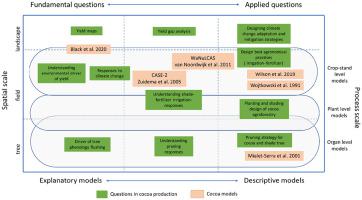Agricultural Systems ( IF 6.1 ) Pub Date : 2023-01-27 , DOI: 10.1016/j.agsy.2023.103614 Ambra Tosto , Alejandro Morales , Eric Rahn , Jochem B. Evers , Pieter A. Zuidema , Niels P.R. Anten

|
CONTEXT
Cocoa is an important commodity crop and source of income for millions of small-holder farmers. Nonetheless, questions on cocoa tree functioning, best management practices and climate change responses remain. Modelling is a powerful tool to address these questions, complementing experimental work that is expensive and time consuming due to the long productive cycle of the cocoa system. However, compared to other crops, cocoa modelling has not received as much attention. OBJECTIVE: We reviewed existing cocoa models and identified the main gaps in the literature and possible strategies to advance models of cocoa production.
METHODS
We first classified relevant research questions in cocoa production along three main axes (fundamental-applied, spatial organization, prediction horizon) and aligned modelling approaches along these. We then reviewed six published cocoa models using these axes as framework. This comparison revealed several modelling gaps for which we provide an overview of data availability for future model development.
RESULTS
(i) Several plant processes (i.e., water stress responses, respiration, climate change responses, nutrient effects and phenology) are either missing from existing cocoa models or are simulated based on general plant physiological knowledge rather than cocoa-specific knowledge. (ii) The only currently existing 3D model of cocoa architecture has very limited scope and does not include physiological processes. (iii) There are no model-based decision support tools available for supporting the main management practices such as irrigation, fertilization and pruning. (iv) Data for model calibration and validation are often scarce.
CONCLUSIONS
We conclude that data availability for model design, calibration and validation is currently the main bottleneck for further development of cocoa models. Extensive cooperation within the cocoa research community and a large network of long-term experiments under different climatic and management conditions are required to close the identified modelling gaps.
中文翻译:

模拟可可生产:回顾建模方法和差距
语境
可可是一种重要的商品作物,也是数百万小农的收入来源。尽管如此,关于可可树功能、最佳管理实践和气候变化应对措施的问题仍然存在。建模是解决这些问题的有力工具,补充了由于可可系统生产周期长而昂贵且耗时的实验工作。然而,与其他作物相比,可可造型并没有受到太多关注。目标:我们回顾了现有的可可模型,并确定了文献中的主要差距和推进可可生产模型的可能策略。
方法
我们首先沿着三个主轴(基本应用、空间组织、预测范围)对可可生产中的相关研究问题进行了分类,并沿着这些轴调整了建模方法。然后,我们使用这些轴作为框架审查了六个已发布的可可模型。这种比较揭示了几个建模差距,为此我们概述了未来模型开发的数据可用性。
结果
(i) 一些植物过程(即水分胁迫反应、呼吸作用、气候变化反应、营养效应和物候)要么在现有的可可模型中缺失,要么是根据一般植物生理知识而不是可可特定知识模拟的。(ii) 目前唯一存在的可可结构 3D 模型范围非常有限,不包括生理过程。(iii) 没有可用于支持灌溉、施肥和修剪等主要管理措施的基于模型的决策支持工具。(iv) 用于模型校准和验证的数据通常很少。
结论
我们得出结论,模型设计、校准和验证的数据可用性是目前进一步开发可可模型的主要瓶颈。需要可可研究界内部的广泛合作以及在不同气候和管理条件下进行的大型长期实验网络,以弥补已确定的建模差距。











































 京公网安备 11010802027423号
京公网安备 11010802027423号